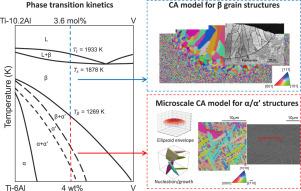定向能沉积 Ti6Al4V 固态相变的微尺度细胞自动机方法
IF 11.1
1区 工程技术
Q1 ENGINEERING, MANUFACTURING
引用次数: 0
摘要
定向能沉积是一种前景广阔的增材制造技术,可通过逐层熔融进料来制造复杂的几何形状。然而,定向能沉积 Ti6Al4V 固态相变过程的形成机理仍不清楚,而这对于理解工艺-结构-性能关系至关重要。本研究提出了一种微尺度细胞自动机方法来模拟 Ti6Al4V 的微观结构演变过程,特别是几个 β 晶粒内的 β→α/α′ 相变过程。该方法进一步与中尺度蜂窝自动机方法、固态相变动力学模型和有限体积方法进行了集成,前者用于预测先期的 β 晶粒结构,后者用于预测相体积分数,后者用于热流体流动建模,并为前者提供温度场。综合数值框架不仅将热历史与相体积分数联系起来,还提供了柱状 β 晶粒结构和针状 α/α′ 晶粒结构,与现有的实验观测结果完全一致。此外,预测结果还揭示了分层α/α′结构及其特殊晶簇的形成机理。通过三层模拟,说明了冷却速率对 α/α′ 晶粒形成的影响。有关 α/α′ 形成机理的研究结果有助于定制 Ti6Al4V 的微观结构,从而在定向能沉积 Ti6Al4V 中获得优异的机械性能。本文章由计算机程序翻译,如有差异,请以英文原文为准。

A microscale cellular automaton method for solid-state phase transformation of directed energy deposited Ti6Al4V
Directed energy deposition is a promising additive manufacturing technology that fabricates complex geometries by fusing feed material layer-by-layer. However, the formation mechanism of the directed energy deposited Ti6Al4V solid-state phase transformation process, which is crucial for understanding the process-structure–property relationship, has remained unclear. In this study, a microscale cellular automaton method is proposed to simulate the microstructure evolution process for Ti6Al4V, specifically the phase transformation process within a few grains. The method is further integrated with the mesoscale cellular automaton method, which predicts the prior grain structure, the solid-state phase transformation kinetics model for the prediction of the phase volume fractions, and the finite volume method, which is used for the thermal-fluid flow modeling, providing a temperature field to the former. The integrated numerical framework not only links the thermal history with the phase volume fractions but also provides the columnar grain structures and acicular grain structures in satisfying agreement with the available experimental observation. Moreover, the predictions shed some light on the formation mechanism of the hierarchical structure and their particular clusters. The influence of the cooling rate on the grain formation is illustrated via the three-layer case simulation. The findings on the formation mechanism of are beneficial in tailoring the microstructure of Ti6Al4V for excellent mechanical properties in directed energy deposited Ti6Al4V.
求助全文
通过发布文献求助,成功后即可免费获取论文全文。
去求助
来源期刊

Additive manufacturing
Materials Science-General Materials Science
CiteScore
19.80
自引率
12.70%
发文量
648
审稿时长
35 days
期刊介绍:
Additive Manufacturing stands as a peer-reviewed journal dedicated to delivering high-quality research papers and reviews in the field of additive manufacturing, serving both academia and industry leaders. The journal's objective is to recognize the innovative essence of additive manufacturing and its diverse applications, providing a comprehensive overview of current developments and future prospects.
The transformative potential of additive manufacturing technologies in product design and manufacturing is poised to disrupt traditional approaches. In response to this paradigm shift, a distinctive and comprehensive publication outlet was essential. Additive Manufacturing fulfills this need, offering a platform for engineers, materials scientists, and practitioners across academia and various industries to document and share innovations in these evolving technologies.
 求助内容:
求助内容: 应助结果提醒方式:
应助结果提醒方式:


